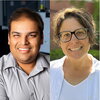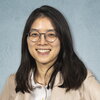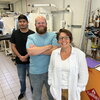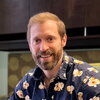Excellence in Inorganic Chemistry
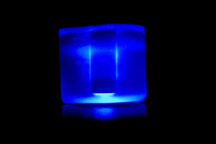 The University of Illinois at Urbana-Champaign is one of the premier institutions for inorganic chemical research, as shown by its ranking as one of the top 5 graduate inorganic programs by US News and World Report. The faculty members not only are leaders in the field, but are also outstanding mentors of graduate students working toward their PhD degrees. Our students have gone on to extremely successful careers as professors at major research universities and as leading scientists and technical officers in industry. The strength of inorganic research at Illinois is unsurpassed anywhere in the US.
The University of Illinois at Urbana-Champaign is one of the premier institutions for inorganic chemical research, as shown by its ranking as one of the top 5 graduate inorganic programs by US News and World Report. The faculty members not only are leaders in the field, but are also outstanding mentors of graduate students working toward their PhD degrees. Our students have gone on to extremely successful careers as professors at major research universities and as leading scientists and technical officers in industry. The strength of inorganic research at Illinois is unsurpassed anywhere in the US.
The graduate program at the University of Illinois covers all areas of modern inorganic chemistry from organometallic chemistry, kinetics/mechanism, and catalysis to the frontiers of materials chemistry, bioinorganic chemistry, and advanced physical characterization. Our students receive an outstanding education and participate in research at the very frontier of science.
Inorganic Chemistry at Illinois in the 21st Century
Currently, the inorganic program at Illinois comprises 10 faculty members, about 50 graduate students, and a dozen postdoctoral fellows. In addition, several other faculty members who have primary research interests in other fields also carry out research in inorganic chemistry. Please look at our research descriptions and feel free to contact any of us to discuss our research interests. You will find that Illinois has a unique blend of scholarly excellence, a stimulating intellectual environment, and a collegial and collaborative atmosphere.
Inorganic Chemistry Faculty
 As evidence of their research excellence, current inorganic faculty members have been recognized by numerous awards and elections to national scientific societies. Among these are the ACS Nobel Laureate Signature Award for Graduate Education, the ACS Award in Inorganic Chemistry, the ACS Award in Organometallic Chemistry, the ACS Arthur Adamson Award for Distinguished Service in the Advancement of Surface Chemistry, the Materials Research Society Medal, the DOE Award for Outstanding Accomplishment in Materials Science, two ACS Cope Scholar Awards, two IUPAC prizes, six national Young Investigator Awards, six Sloan Foundation Fellowships, five Dreyfus Teacher-Scholar Awards, three Fellows of the American Association for the Advancement of Science, a Howard Hughes Medical Institute Professors Award, the Sir George Stokes Medal of the Royal Society of Chemistry, the Leo Hendrik Baekeland Award, the Union Carbide Innovative Recognition Award, the NIH Research Career Development Award, the NSF Special Creativity Award, the Cottrell Scholars Award of the Research Corporation, and the Silver Medal of the Royal Society for Arts, Manufactures, and Commerce.
As evidence of their research excellence, current inorganic faculty members have been recognized by numerous awards and elections to national scientific societies. Among these are the ACS Nobel Laureate Signature Award for Graduate Education, the ACS Award in Inorganic Chemistry, the ACS Award in Organometallic Chemistry, the ACS Arthur Adamson Award for Distinguished Service in the Advancement of Surface Chemistry, the Materials Research Society Medal, the DOE Award for Outstanding Accomplishment in Materials Science, two ACS Cope Scholar Awards, two IUPAC prizes, six national Young Investigator Awards, six Sloan Foundation Fellowships, five Dreyfus Teacher-Scholar Awards, three Fellows of the American Association for the Advancement of Science, a Howard Hughes Medical Institute Professors Award, the Sir George Stokes Medal of the Royal Society of Chemistry, the Leo Hendrik Baekeland Award, the Union Carbide Innovative Recognition Award, the NIH Research Career Development Award, the NSF Special Creativity Award, the Cottrell Scholars Award of the Research Corporation, and the Silver Medal of the Royal Society for Arts, Manufactures, and Commerce.
The Link from the Past to the Future
 Today’s excellence in inorganic chemistry at the University of Illinois builds on a distinguished legacy. John C. Bailar almost single-handedly created the field of inorganic chemistry in the US. From the 1930s through the 1960s, a remarkably large fraction of all the inorganic chemistry PhDs in the US came from the Bailar laboratories. Professor Bailar served as President of the American Chemical Society (three of his students did also), and he founded both the ACS journal, Inorganic Chemistry, and the ACS Division of Inorganic Chemistry. He made significant advances in understanding the stereochemistry of metal coordination complexes, was a pioneer in the development of homogeneous hydrogenation catalysis, and initiated the field of inorganic coordination polymers. Professors C. W. Balke, B. Smith Hopkins, and Therald Moeller made Illinois a world leader in the chemistry of the lanthanides, and Lou Audrieth's interests in the chemistry of nitrogen and phosphorus led to the discovery of sodium cyclamate, which today is used as an artificial sweetener in over 55 countries worldwide. Ted Brown, Stan Piper, Russ Drago, and Galen Stucky led research at Illinois into the new areas of spectroscopy, electronic structure, acid-base theory, and organometallic chemistry. John Shapley, Walter Klemperer, and Dave Hendrickson added new themes: the chemistry of metal carbonyl clusters and polyoxometalates, particularly as models of surface chemistry, and detailed studies of the phenomenon of magnetism. Under the leadership of these chemists, the inorganic graduate program at Illinois grew to be the largest and most active in the country, attributes that continue today.
Today’s excellence in inorganic chemistry at the University of Illinois builds on a distinguished legacy. John C. Bailar almost single-handedly created the field of inorganic chemistry in the US. From the 1930s through the 1960s, a remarkably large fraction of all the inorganic chemistry PhDs in the US came from the Bailar laboratories. Professor Bailar served as President of the American Chemical Society (three of his students did also), and he founded both the ACS journal, Inorganic Chemistry, and the ACS Division of Inorganic Chemistry. He made significant advances in understanding the stereochemistry of metal coordination complexes, was a pioneer in the development of homogeneous hydrogenation catalysis, and initiated the field of inorganic coordination polymers. Professors C. W. Balke, B. Smith Hopkins, and Therald Moeller made Illinois a world leader in the chemistry of the lanthanides, and Lou Audrieth's interests in the chemistry of nitrogen and phosphorus led to the discovery of sodium cyclamate, which today is used as an artificial sweetener in over 55 countries worldwide. Ted Brown, Stan Piper, Russ Drago, and Galen Stucky led research at Illinois into the new areas of spectroscopy, electronic structure, acid-base theory, and organometallic chemistry. John Shapley, Walter Klemperer, and Dave Hendrickson added new themes: the chemistry of metal carbonyl clusters and polyoxometalates, particularly as models of surface chemistry, and detailed studies of the phenomenon of magnetism. Under the leadership of these chemists, the inorganic graduate program at Illinois grew to be the largest and most active in the country, attributes that continue today.
Related News
- For nearly 30 years, scientists studying light-driven palladium-catalyzed reactions have suspected that a fleeting species of palladium plays a key role in the process. Leveraging their...
- CHAMPAIGN, Ill. — Benjamin Snyder, a professor of chemistry at the University of Illinois Urbana-Champaign, has been named a...
- Three faculty members in the Department of Chemistry have received promotions. Josh Vura-Weis has been promoted to full professor by the University of Illinois at Urbana-Champaign. And Hee-Sun Han...
- Researchers at the University of Illinois Urbana-Champaign have discovered important new clues in the mystery of how an ancient enzyme can turn atmospheric carbon into biomolecules, a natural...
- Three Illinois scientists are among 126 recipients of the 2025 Sloan Research Fellowships from the Alfred P. Sloan Foundation....
- Hee-Sun Han, assistant professor of chemistry and Cancer Center at Illinois (CCIL) member and assistant professor of chemistry has...
- The Electrochemical Society awarded the 2024 Electrodeposition Division Research Award to Professor Andrew A. Gewirth...
- The American Chemical Society's Board of Directors has awarded Petroleum Research Fund grants to 126 researchers, including chemistry professor Liviu M...
- With a natural enzyme as inspiration, researchers at the University of Illinois Urbana-Champaign have designed an artificial enzyme that converts methanol to formaldehyde in a process that has the...
- Sixty-nine researchers received American Chemical Society Petroleum Research Fund (ACS PRF) grants following the spring 2024 application process, including...
- The Camille Dreyfus Teacher-Scholar Awards Program supports the research and teaching careers of talented young faculty in the chemical sciences.
Related Content
- Receiving the 2024 T.S. Piper Award for Outstanding Inorganic Thesis is a great honor, said Joe Lastowski. “I feel very privileged to have the opportunity to obtain a PhD from UIUC and...
- Growing up in Taiwan, Chi-Herng "Daniel" Hu dreamed of studying in the United States and earning his doctorate. After graduating from National Taiwan University in 2017 with a bachelor's degree in...
- Jason Wu is a graduate student from Newton, MA, pursuing his doctorate in the research groups of chemistry Prof. Nick Jackson and chemical and biomolecular engineering Prof. Charles Schroeder....
- Fall 2024 Boron-doped acenes and their emissive properties Siddhartha Banerjee MXing Electrochemical Hydrogen Evolution with MXenes Tathagata...




